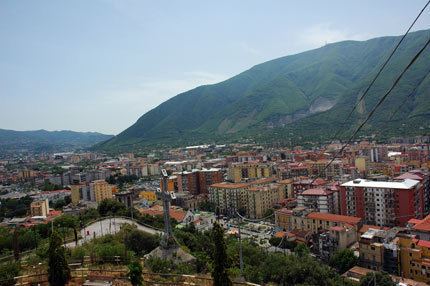Demonym(s) Nocerini Population 46,266 (31 May 2015) Postal code 84014 | Elevation 43 m (141 ft) Local time Tuesday 11:53 PM | |
 | ||
Frazioni Cicalesi, Merichi, Vescovado, Casolla, San Mauro Weather 12°C, Wind N at 5 km/h, 66% Humidity | ||
Nocera Inferiore is a city and comune in Campania, Italy, in the province of Salerno, at the foot of Monte Albino, 20 km east-south-east of Naples by rail.
Contents
- Map of 84014 Nocera Inferiore Province of Salerno Italy
- History
- Main sights
- Basilicas
- Churches
- Castle
- Buildings
- Museums
- Notable people
- Transportation
- References
Map of 84014 Nocera Inferiore, Province of Salerno, Italy
History
In the period before the Roman supremacy in southern Italy, Nuceria Alfaterna, situated between the current Nocera Inferiore and Nocera Superiore, appears to have been the chief town in the valley of the river Sarnus, with Herculaneum, Pompeii, Stabiae and Surrentum all being dependent upon it. Nuceria minted its own money, its coins bearing the head of the river god, and developed its own alphabet called nucerino and which derived from the Etruscan language. It maintained its allegiance to Rome until 309 BC when it joined the revolted Samnites. In 308 BC it repulsed a Roman attempt to land at the mouth of the Sarnus, but in 307 BC it was besieged and surrendered. It obtained favourable terms, and remained faithful to Rome even after Cannae.
Hannibal reduced it in 216 BC by starvation, and destroyed the town. The inhabitants returned when peace was restored. Even during the Social War Nuceria remained true to Rome, though the dependent towns joined the revolt; after it they were formed into independent communities, and Nuceria received the territory of Stabiae, which had been destroyed by Sulla in 89 BC, as a compensation. In 73 BC it was plundered by Spartacus.
At an early date the city became an episcopal see, and in the 12th century it sided with Innocent II against Roger of Sicily, and suffered severely for its choice.
In the 13th century, and long after, the town had the name of Nocera de' Pagani (Nocera of the pagans) because a colony of Muslim Saracens was introduced by Frederick II. The town was described as "a genuine Muhammadan town with all its characteristic mosques and minarets." It is said that, through their darker complexion and features, the townsfolk maintain the heritage of these Muslims settlers. Notably, while the towns name was changed from Nocera de' Pagani to Nocera Inferiore, a nearby town, Nuceria Christianorum, was renamed Nocera Superiore. But in 1239 Frederick II decided to expell the Muslim population of Nocera and the city was abandoned.
A small colony of Saracens was actually introduced in the town around the 9th century.
By the end of 15th century, until 1806 had the epithet ("of the pagans", Nuceria Paganorum). Today there is the town of Pagani, which lies about one 1.5 km to the west.
In 1385 Pope Urban VI was besieged in the castle by Charles III of Naples.
Main sights
Helena, the widow of Manfred of Sicily, was imprisoned in the Castle and died here after the battle of Benevento (1268). Here also Urban VI imprisoned the cardinals who favoured the antipope Clement VII. The castle also had as guests the writers Dante Alighieri and Boccaccio.
About three kilometers to the east, near the village of Nocera Superiore, is the circular church of Santa Maria Maggiore, dating from the 6th century. Its chief feature is its dome, ceiled with stone internally, but covered externally with a false roof. It is supported by 40 ancient columns, and in its construction resembles Santo Stefano Rotondo in Rome. The walls are covered with frescoes from the 14th century.
Basilicas
Churches
Castle
Buildings
Museums
Notable people
Transportation
Nocera is connected with Naples, Avellino and Salerno by a branch railway.
